Shopify Success Rate: Tips for Success & Traps to Avoid

Whether your Shopify store is a hobby, a money-making side hustle, or a full-time venture, you obviously want it to generate plenty of traffic, sales, and revenue.
While there are no guarantees in the world of e-commerce, you’ll have a far higher chance of succeeding if you avoid common pitfalls and leverage the most impactful growth strategies.
What is the Success Rate of Shopify Stores?
If you’re searching Google to find the average Shopify success rate, you’ll come across two widely quoted — and seemingly contradictory — “statistics”.
One claims Shopify has a success rate of around 5% – 10%, meaning up to 95% of stores fail.
The other, supposedly based on Shopify data (although we couldn’t find a link to that data), insists that 81% of Shopify merchants are still active and profitable after two years.

Unless all those profitable stores suffer a dramatic slump in performance shortly after the two-year mark, it doesn’t feel like both of those stats can be correct.
In reality, Shopify doesn’t publish success rate data. And why would it? If you knew that a high proportion of Shopify stores don’t last the distance, you might not bother starting your own.
However, it’s possible to find general statistics on business success rates. For instance, the US Small Business Association’s Office of Advocacy revealed that between 1994 and 2019…
- An average of 67.6% of new employer establishments survived at least two years
- The five-year survival rate was 48.9%
- The 10-year survival rate was 33.6%
- The 15-year survival rate was 25.7%
In other words, the majority of businesses make it through the first year, but few are still going strong 10+ years down the line.
14 Reasons Why Shopify Stores Fail
Shopify stores rarely fail for one single reason; more likely it’s down to a combination of factors that curb their growth and eat away at their revenue. Those factors include…
Bad Customer Service
You might think your customers would stick with you through thick and thin.
Unfortunately, data suggests that’s simply not the case. PwC found that 32% of consumers would walk away from a brand they loved after a single bad experience, while 59% would do so after several poor experiences.

If you’re going to retain your most loyal shoppers, you need to nail your customer service.
Yet only 49% of US consumers say companies currently provide a good customer experience, so there’s clearly a significant gap between expectation and reality.
Bad User Experience
Did you know that 60% of consumers abandon purchases due to poor website user experience (UX)? Or that 21% of shoppers say slow-loading pages are their main source of dissatisfaction when shopping online?

Either way, it’s clear that many Shopify stores are being held back by UX issues such as…
- Cluttered or complex website navigation
- Overly intrusive popups
- Lack of accessibility
- Poor functionality on mobile devices
- Vague or conflicting calls to action (CTAs)
While optimizing your UX takes time (and lots of testing), the rewards are well worth the effort. The easier your store is to navigate, the higher your Shopify conversion rates will be.
Lack of Well-Defined Goals
Poor website UX often stems from a lack of clearly defined goals.
For instance, you might think it makes sense to add multiple CTAs — buy now; shop the sale; subscribe to our newsletter — to a landing page. Because those are all useful goals. But in reality, you’re asking shoppers to do too many things, which dilutes your messaging and makes your calls to action less impactful.
Each page on your site and every piece of marketing collateral you create should have a single, clear-cut objective in mind. And those objectives should feed into your overarching business goals.
Lack of Buying Options
One in nine shoppers ultimately abandon their shopping carts because there weren’t enough payment methods available, according to the Baymard Institute. So it makes sense to offer as many options as possible.
The likes of Apple Pay, Google Pay, and PayPal are obvious choices. But you should also consider buy now, pay later (BNPL) services like Affirm and Afterpay. Over one-third of Americans have used BNPL at some point, rising to half of 25 to 44-year-olds.

Poor Niche
Unless you’re a huge retailer like Amazon or eBay, you need to find the right niche for your Shopify store. Otherwise, you’ll be competing with the biggest e-commerce marketplaces on the planet — and it’s not a battle you’re likely to win. This becomes even more important if you’re dropshipping Shopify products, because you need to stand out against all the other stores selling exactly the same thing.
Your goal here is to find a profitable niche-within-a-niche. For instance, rather than selling men’s clothing, you could specialize in sustainable men’s denimwear. Or instead of opening a store for pet products, you could focus on smart gadgets for cat owners.
However, not all niches are guaranteed money-spinners.
Some are simply too competitive for new entrants to break through. Some are dominated by a handful of large incumbents. And some just don’t have a big enough audience or high-enough profit margins.
Low Profit Margins
Speaking of profit margins…
Some niches or business models don’t offer enough scope for you to turn a decent profit.
Not only does this stifle your growth, but it limits your ability to run attractive promotions and offer low-cost shipping options. All of which makes it harder to attract and convert new customers.
Poor Product Choice
Even with the perfect niche, your store is only as strong as the products you sell. Many Shopify entrepreneurs fail simply because they pick the wrong products, items with low demand, razor-thin margins, or saturated competition. Choosing winning products isn’t about guesswork; it’s about strategy.
That means asking key questions like:
- Is there real demand for this product?
- Are people actively searching for it?
- How saturated is the market?
- What are my competitors doing right (or wrong)?
If you’re relying on gut instinct instead of data, you’re putting your business at risk.
Solution: Use a dedicated product research tool for Shopify like ZIK Analytics to make informed decisions based on live eCommerce data. ZIK helps you uncover profitable products on platforms like eBay and Shopify, monitor market trends, and spy on successful competitors, so you avoid sinking time and money into products that simply won’t sell.
Product research is one of the most overlooked (yet most critical) steps to Shopify success. Don’t skip it.
No Product Differentiation
In addition to product choice, your store also needs some point of differentiation.
It doesn’t have to be through your product range; you can also stand out through your…
- Pricing strategy
- Brand story
- Customer service
…or something else entirely.
But there’s no getting away from the fact that if you essentially sell the same products as your competitors, it’s going to be harder for you to cut through — especially if those competitors are better established than you.
Inadequate Upsells, Cross-Sells, and Associated Products
According to McKinsey, cross-selling and category-penetration strategies increase sales by 20% and profits by 30%.
And then there’s upselling: the practice of persuading customers to purchase a higher-priced, “premium” version of the product they were planning to buy.
Combined, these selling strategies have a big impact on your bottom line, increasing your average order value and basket size. Get it wrong and you’ll miss out on a ton of extra sales and revenue.
Brooklinen is a master of upselling, cross-selling, and associated product recommendations.
It marks premium products with a “bestseller” tag and uses aspirational language to describe them…
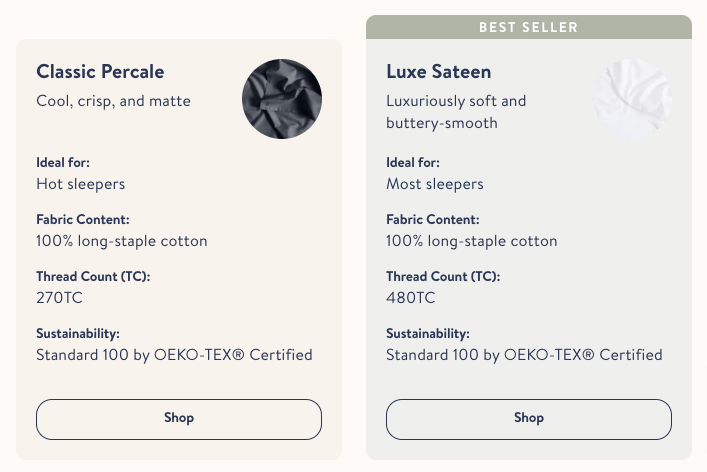
…as well as adding a “you may also like” section to all product pages:
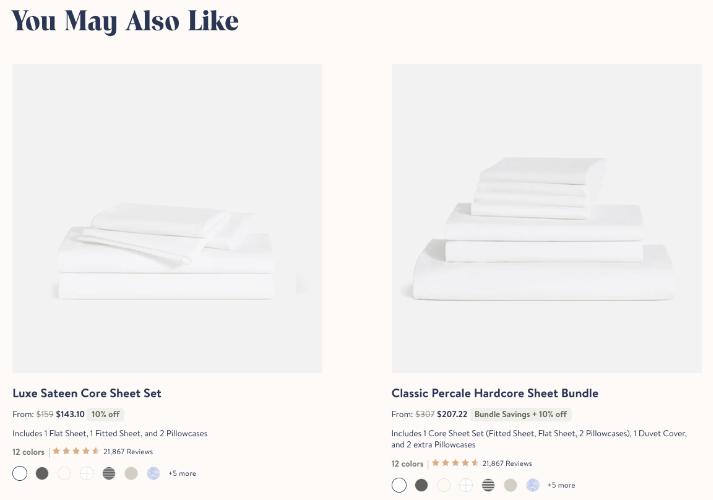
Lack of Social Proof
Psychologist Robert Cialdini invented the term “social proof” to describe the phenomenon by which we often base our decisions on other people’s actions.
It’s why we’re more likely to visit “cool” bars or vacation spots. And it’s also why we gravitate toward products that are recommended by influencers, social media users, reviewers, and our peers.
Social proof comes in many shapes and sizes, including:
- Reviews
- Customer testimonials
- Expert endorsements
- Trust badges
- User-generated content
Deployed effectively, it can help you build a more credible brand. Which, in turn, makes it more likely new customers will buy from you.
So if you don’t leverage social proof in your marketing, you risk looking untrustworthy, which can damage your sales.
All of which results in higher conversion rates, more sales, and greater customer loyalty.
Learn more in our guide to social proof (and how to incorporate it in your e-commerce store).
Little to No Reviews
Reviews are one element of social proof. But they’re important enough to warrant their own section in this article.
Why?
Because reading reviews is the #1 way consumers research unfamiliar online brands before buying.
While your review score is important, it isn’t the be all and end all. Volume matters, too. Customers are more likely to trust brands with a higher number of reviews, even if their review scores are identical:
So it’s in your best interests to capture as many reviews as possible (even if not all those reviews are totally glowing).
Poor Product Imagery
Online shoppers can’t physically touch your products, so they have to rely on your product imagery to tell the story instead.
Low-quality (or insufficient) imagery can make your products look cheap and generally undesirable. It can even make your store look untrustworthy.
Either way, it’s definitely going to damage your sales.
Nail your product imagery by reading our guide to Shopify image optimization.
No Strategy
We get it: you’re excited to launch your e-commerce store.
But you can’t afford to skimp on the upfront strategy work.
Without a detailed e-commerce strategy, you’re setting yourself up for failure. Your strategy should incorporate the various tactics you’ll be using to achieve your business goals, detailing how you plan to:
- Get in front of new customers
- Convert first-time website visitors
- Turn first-time buyers into loyal repeat customers
Not sure where to begin? Check out our ultimate guide to building an e-commerce strategy.
Shipping Problems
“Delivery speed” and “delivery cost” are the two biggest factors influencing whether or not a shopper will buy from an e-commerce store.
So if your shipping options aren’t up to scratch, people aren’t going to buy from you in the first place.
But shipping problems aren’t just about what happens before a customer makes a purchase decision.
Remember: one-third of shoppers are prepared to break up with brands they love after just one negative experience. So a single late delivery or missed order could cost you a loyal customer.
How to Make Your Shopify Store a Success
Sure, there are lots of things that can set you up for failure as a Shopify store owner. But there are also plenty of ways to position your store for success, including:
- Choosing a Shopify theme that’s responsive, easy to navigate, and compatible with multiple browsers.
- Optimizing your store structure so it naturally guides users from landing pages to product pages (and, ultimately, to your checkout pages).
- Optimizing your images by compressing them, using the right dimensions, and adding relevant keywords to the metadata.
- Creating urgency by running time-limited promotions and using actionable language.
- Using landing page popups to grow your email marketing list.
- Encouraging cross-sells through email marketing and onsite popups.
- Using exit-intent popups to target visitors about to leave your store.
- Adding product badges to collections pages to promote discounts and showcase your best-selling products.
Want more advice on building and maintaining a successful Shopify store? Check out our roundup of 18 Shopify hacks to turbocharge your sales!
7 Common Signs of Shopify Success
Part of running a successful Shopify business is about recognizing whether your store is heading in the right direction. If not, you can course-correct before any lasting damage has been done.
With that in mind, here are seven key indicators that your store is on the right path:
1. Revenue Growth
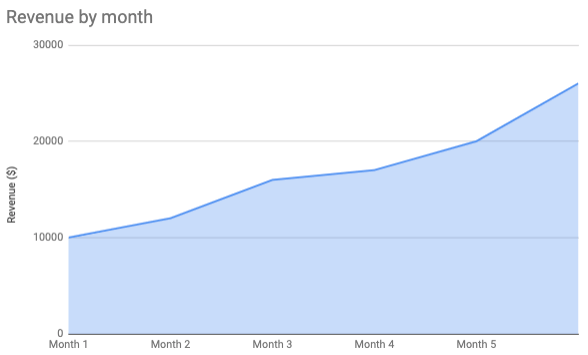
This one’s pretty simple: if your revenue is growing consistently, it’s a decent indication that you’re reaching the right audience — and they like what you’re selling.
Of course, revenue growth doesn’t tell the full story. If you’re overly reliant on aggressive promotions or low prices, all that revenue might not equate to a sustainable, profitable business.
That’s why you also need to consider other factors, such as…
2. Large/Increasing Volumes of Website Visitors
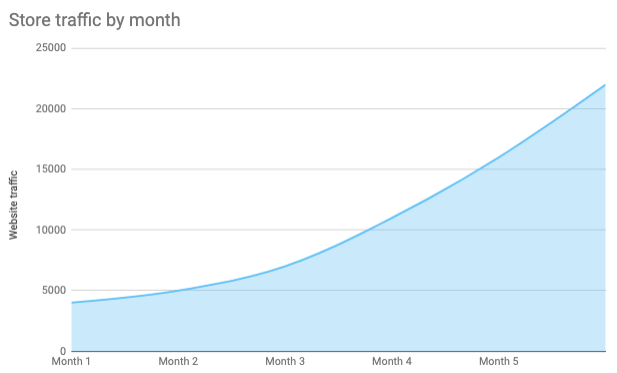
If your traffic is on an upward curve, it suggests:
- Your brand awareness is growing
- You’re in a niche with a decent total addressable market
- Your marketing efforts are paying off
Every person who visits your site represents a sales opportunity. And, generally speaking, the more of those opportunities you generate, the better your chances of success.
But what if none of those store visitors turn into paying customers?
3. Successful Conversion Rates
A strong conversion rate is a solid indication that you’re targeting the right customers, your product is in demand, and your prices are attractive.
But what does a good conversion rate actually look like?
According to IRP Commerce, the average e-commerce rate fluctuates by month, with 2022 seeing a low of 1.65% in August and a peak of 2.17% in December. However, these figures vary widely between niches:
Shopify stores typically turn 1.4% of their visitors into buyers. Email referrals are the most effective, with an average of 4.29% of people visiting from emails deciding to buy something.
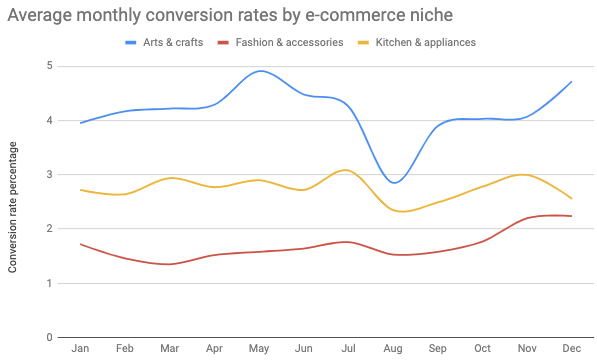
So you’ll need to run some niche-specific analysis to gauge the health of your conversion rate.
4. Low Rate of Returns/Refunds
A low return rate speaks to the quality of your product and the relevance of your messaging: you’re clearly not misleading customers or giving them unrealistic expectations.
As with conversion rate, your return rate figure requires a little context before you can judge whether it’s in a good place.
Data from the National Retail Federation and Appriss Retail shows an average blended retail return rate of 10.6%.
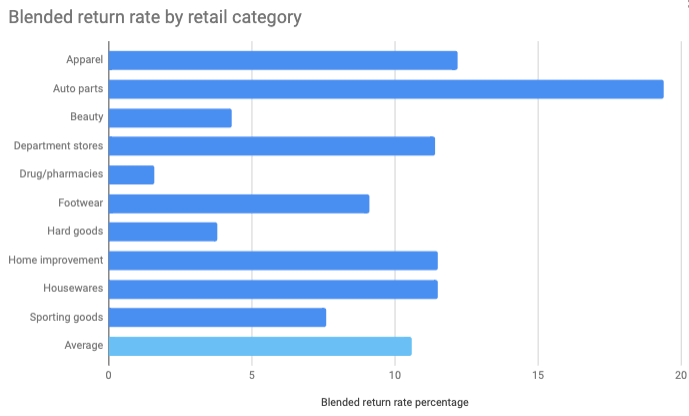
But, as you can see, there are significant variations from one industry to the next.
5. Positive Profit Margins
Now we’re getting to metrics that speak to the long-term viability of your e-commerce business.
If you’re able to maintain healthy profit margins while sustaining a strong conversion rate and growing your revenue, it’s a sure sign your Shopify store is succeeding.
6. Strong Customer Retention Rates
According to Gorgias, repeat customers account for 44% of revenue and 46% of orders, yet they make up just 21% of an average e-commerce brand’s customer base.
So if you can build a core of loyal customers who buy from you time and time again, you’ll massively increase your chances of e-commerce success.
Figures from Metrilo show the average e-commerce repeat purchase rate stands at 28.2%.
However — you guessed it — there are some big variances across different industries:
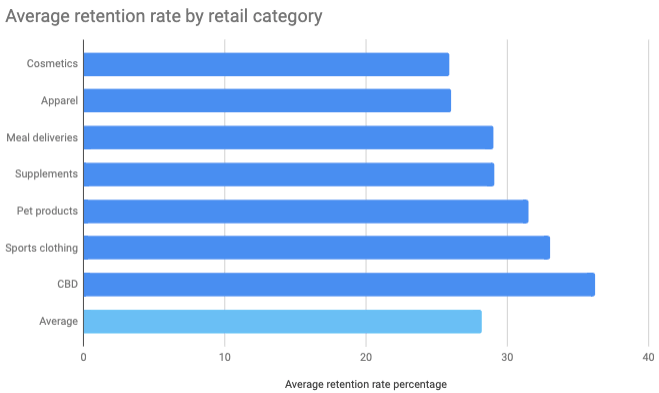
7. Consistent Expansion in Customer Base
Of course, you don’t just want to sell to the same loyal customers — you also want to reach and convert new audiences.
Realistically, you can’t grow your customer base indefinitely; eventually you hit the natural limit of your niche (at which point you might consider expanding into new verticals).
But if you’re bringing in a growing number of new customers, that’s a fantastic indication that you’ve chosen a profitable niche, and that your products and pricing strategy stack up well versus your competitors.
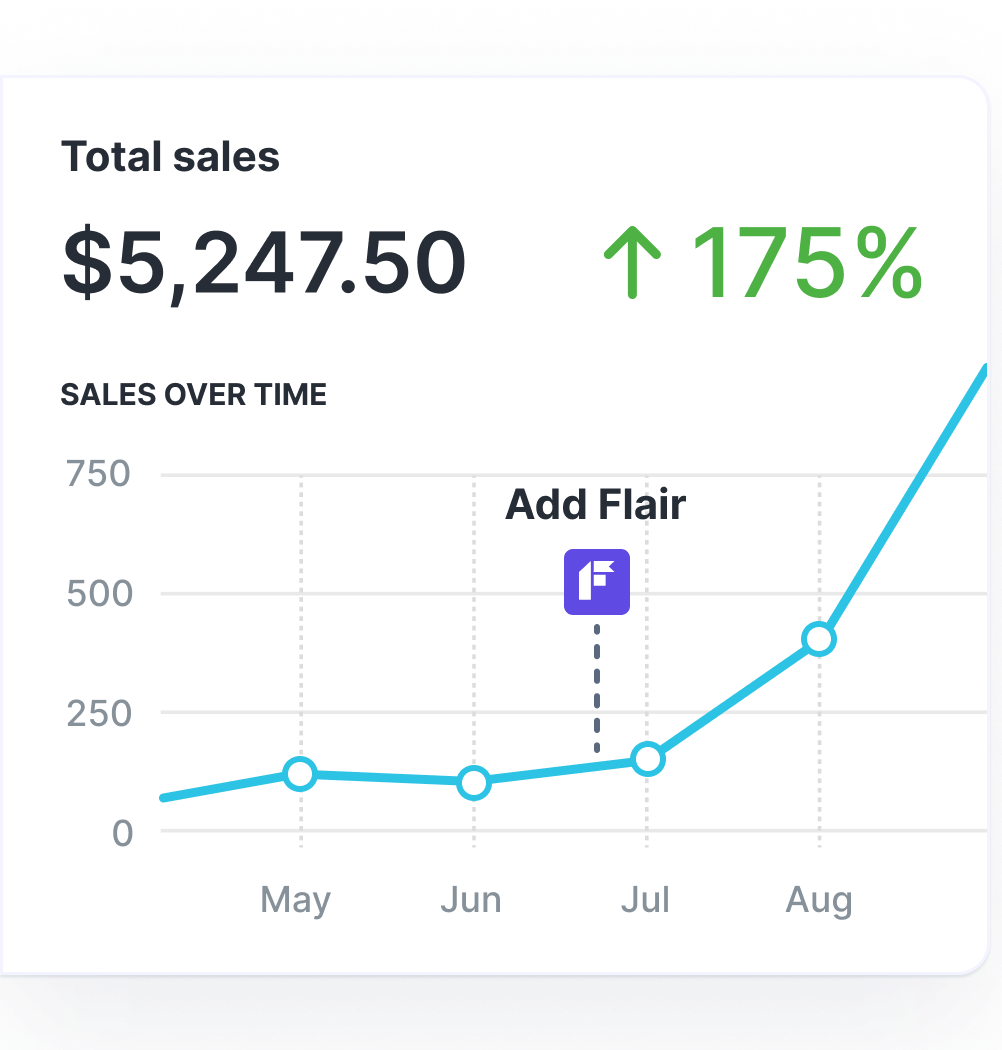
Grow Your Shopify Sales by over 175% with Flair
-
Increase sales using product badges and sales banners
-
Maximize conversions with scarcity, urgency and countdown timers
-
Automate promotions with targeted rules and scheduling
Other FAQs
How Many Shopify Stores Are Successful?
Several sources claim the average Shopify success rate is 5% – 10%, meaning up to 95% of Shopify stores ultimately fail.
However, figures from the US Small Business Association’s Office of Advocacy reveal that between 1994 and 2019, two-thirds of all new businesses survived for at least two years. So you’ve got a decent chance of making it through the early days; it’s all about how you grow from there.
What Kind of Shopify Stores Are Successful?
Some of the most successful Shopify stores include:
| Brand | Niche | Estimated revenue |
| Allbirds | Footwear | $297.8 million |
| Gymshark | Fitness apparel | $605.3 million |
| Bombas | Apparel & accessories | $100+ million |
| MVMT Watches | Watches | $150+ million |
| Fashion Nova | Fashion | $200+ million |
So while it’s possible to build a successful e-commerce store in a wide range of verticals, Shopify is particularly well suited to B2C brands in fashion-related niches.
How Much Do Successful Shopify Stores Make?
The top 20% of Shopify stores earn $209+ per customer, climbing to $326+ for the top 10% of stores.
Can You Become Successful With Shopify?
Yes! There are tens of thousands of successful Shopify stores out there. While only a handful of stores make tens or hundreds of millions of dollars in annual revenue, plenty of store owners are earning a tidy income through Shopify, thanks to the platform’s attractive themes and wealth of tools to attract and convert customers.
How Long Does it Take to Make Money on Shopify?
It’s totally possible to start generating sales within minutes of launching your Shopify store. However, for most businesses, it takes weeks or months to start building a consistent revenue stream — and longer still to turn a healthy profit.
How Much Does the Average Shopify Owner Make?
On average, Shopify store owners make approximately $27,500 per year, or about $2,292 per month.
We calculated this figure by dividing Shopify’s most recent gross merchandise volume at time of writing ($55 billion) by the most recently reported total number of Shopify merchants (2 million).
That gave us an annual figure of $31,428.57, equating to $2,619.05 per month.
In reality, the figure is probably lower, as Shopify presumably now has more than 1.75 million merchants. We just don't know exactly how many.
What Is the Average Profit Per Month From a Shopify Store?
The average Shopify store owner earns a profit of approximately $13,445 per year, or about $1,120 per month.
How did we reach this figure?
Shopify no longer regularly reports the number of merchants using the platform, but when it last announced this data — back in February 2021 — it gave a figure of 1.75 million merchants.
Meanwhile, Shopify’s latest earnings announcement revealed a gross merchandise volume of $55 billion. If you divide that total by the number of merchants, you get an annual figure of $31,428.57.
Multiplying that figure by the average gross profit margin of 42.78% for online retailers, as reported by the NYU Stern School of Business, gives us an average annual profit of $13,445.14 — or about $1,120 per month.







